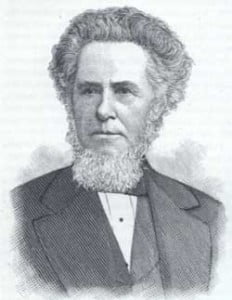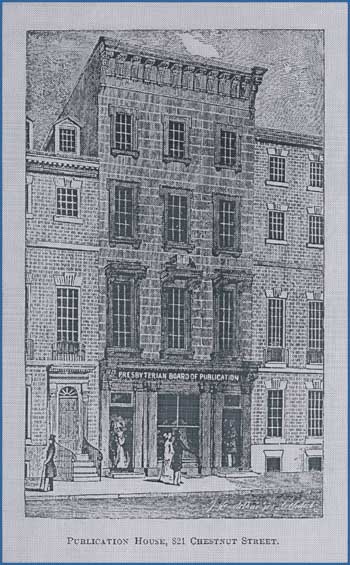The 100th General Assembly of the PCUSA was notable as the first time in which the disrupted Church, North and South, met fraternally. The Southern Presbyterian Church, while meeting in Assembly in Baltimore, came to meet with the Northern Presbyterians during their Assembly in Philadelphia. Discusssions of a permanent reunion were on the table, but nothing came of it. News of that event, as reported in a denominational magazine of the day, follows:
THE PRESBYTERIAN CONGRESS.
The great Presbyterian Congress—its General Assembly—begins its sessions in Philadelphia to-day. As our Philadelphia dispatches showed yesterday, it is a body notable for the number of distinguished divines and laymen who are to lead its deliberations. Of the 500 delegates in attendance a large majority are prominent in the States from which they come, and there are scores of men who are known and honored all over the country, while some of them are recognized by Protestants the world over, as leaders of the religious thought and action of the age.
The great gathering suggests more than ecclesiastical or denominational considerations and reminiscences. It reminds intelligent students of the history of this country of the intimate relations between Presbyterianism in its various forms with the history of the struggles for religious and political freedom, in the old world and in the new. It was the love of freedom of the Presbyterians in Great Britain that brought on them the persecutions and trials that drove here hundreds of thousands of Presbyterians, who became the staunchest and most intelligent supporters of American independence. The same causes gave to the American colonies the splendid qualities for citizenship that were possessed by the exiled Huguenots and by the Dutch Presbyterians. It was a natural and most vitally important result that during the whole period of the Revolutionary war the Presbyterian churches were unanimously for American independence and furnished a large proportion of the ablest civil and military leaders who conducted the war and founded the Union.
One of the most notable concessions as to the harmony between Presbyterianism and our peculiar form of government was made by the Roman Catholic Archbishop of New York, John Hughes, when he wrote these words:
“Though it is my privilege to regard the authority exercised by the General Assembly as usurpation, still I must say with every man acquainted with the mode in which it is organized, that for the purpose of popular and political government, its organization is little inferior to that of Congress itself. It acts on the principle of a radiating centre, and is without equal or rival among the other denominations of the country.”
[excerpted from The Church at Work, 2.34 (31 May 1888): 3.]
President Grover Cleveland’s Address to the Members of the General Assemblies.
[The Church at Work, 2.34 (31 May 1888): 4]
I am very much gratified by the opportunity here afforded me to meet the representatives of the Presbyterian Church. Surely, a man never should lose his interest in the welfare of the church in which he was reared. Those of us who inherit fealty to our church as I do, begin early to learn those things which make us Presbyterians all the days of our lives, and thus it is that the rigors of our early teaching, by which we are grounded, in our lasting allegiance, are especially vivid, and perhaps, the best remembered. The attendance upon church service three times each Sunday, and upon Sabbath school during the noon intermission, may be irksome enough to a boy of ten or twelve years of age to be well fixed in his memory, but I have never known a man who regretted these things in the years of his maturity. The Shorter Catechism, though thoroughly studied and learned, was not, perhaps, at the time, perfectly understood, and yet in the stern labors and duties of after life those are not apt to be the worst citizens who were taught “What is the chief end of man.”
Speaking of these things, and in the presence of those here assembled, I may say the most tender thoughts crowd upon my mind—all connected with Presbyterianism, and its teachings. There are present with me now memories of a kind and affectionate father, consecrated to the cause and called to his rest and his reward, in the mid-day of his usefulness; a sacred recollection of the prayers and pious love of a sainted mother, and a family circle hallowed and sanctified by the spirit of Presbyterianism. I cannot but express the wish and the hope that the Presbyterian church will always be at the front in every movement which promises the temporal as well as the spiritual advancement of mankind.
In the turmoil and bustle of every day life few men are foolish enough to ignore the practical value to our people and our country of the church organization established among us, and the advantage of Christian example and teaching. While we may be pardoned for insisting that our denomination is the best, we may, I think, safely concede much that is good to all other churches that seek to make men better.
I am here to greet the delegates of two General Assemblies of the Presbyterian Church. One is called “North” and the other “South.” The subject is too deep and intricate for me, but I cannot help wondering why this should be. These words, so far as they denote separation and estrangement, should be obsolete. In the councils of the Nation and in the business of the country they no longer mean reproach and antagonism. Even the soldiers who fought for the “North” and for the “South” are restored to fraternity and unity. This fraternity and unity is taught and enjoined by our church. When she shall herself be united, with all the added strength and usefulness, then harmony and union ensue.
Words to Live By:
How the mighty have fallen. How some have departed over these many years from the clear proclamation of the glorious Gospel of Jesus Christ. We take no pride in making such an observation. If anything, we should be immensely humbled, knowing our own sinful hearts. Indeed, we should fear the Lord and daily strive to draw near to Him. May the Lord by His Holy Spirit bring repentance. May He revive His Church in these latter days.
Therefore let him who thinks he stands take heed that he does not fall.—I Corinthians 10:12, NASB.





 While THIS DAY IN PRESBYTERIAN HISTORY is sponsored by the PCA Historical Center, we have from the start taken a wider scope in the subjects covered here, not limiting ourselves to just the denomination known as the Presbyterian Church in America. The larger history of American Presbyterianism provides the context for our own specific story. Then too, while we could limit ourselves just to PCA subjects, our denomination is very much a conglomeration of churches drawn from nearly every other American Presbyterian denomination, and so it seems fitting to draw on the wider history of American Presbyterianism. Lastly, as Christians, it seems appropriate to lay claim to the history of other believers in our tradition—to find opportunities to praise God for the efforts of men and women of an earlier time who called Jesus their Lord and Savior, who faithfully served in His kingdom, and who were also known as Presbyterians.
While THIS DAY IN PRESBYTERIAN HISTORY is sponsored by the PCA Historical Center, we have from the start taken a wider scope in the subjects covered here, not limiting ourselves to just the denomination known as the Presbyterian Church in America. The larger history of American Presbyterianism provides the context for our own specific story. Then too, while we could limit ourselves just to PCA subjects, our denomination is very much a conglomeration of churches drawn from nearly every other American Presbyterian denomination, and so it seems fitting to draw on the wider history of American Presbyterianism. Lastly, as Christians, it seems appropriate to lay claim to the history of other believers in our tradition—to find opportunities to praise God for the efforts of men and women of an earlier time who called Jesus their Lord and Savior, who faithfully served in His kingdom, and who were also known as Presbyterians.